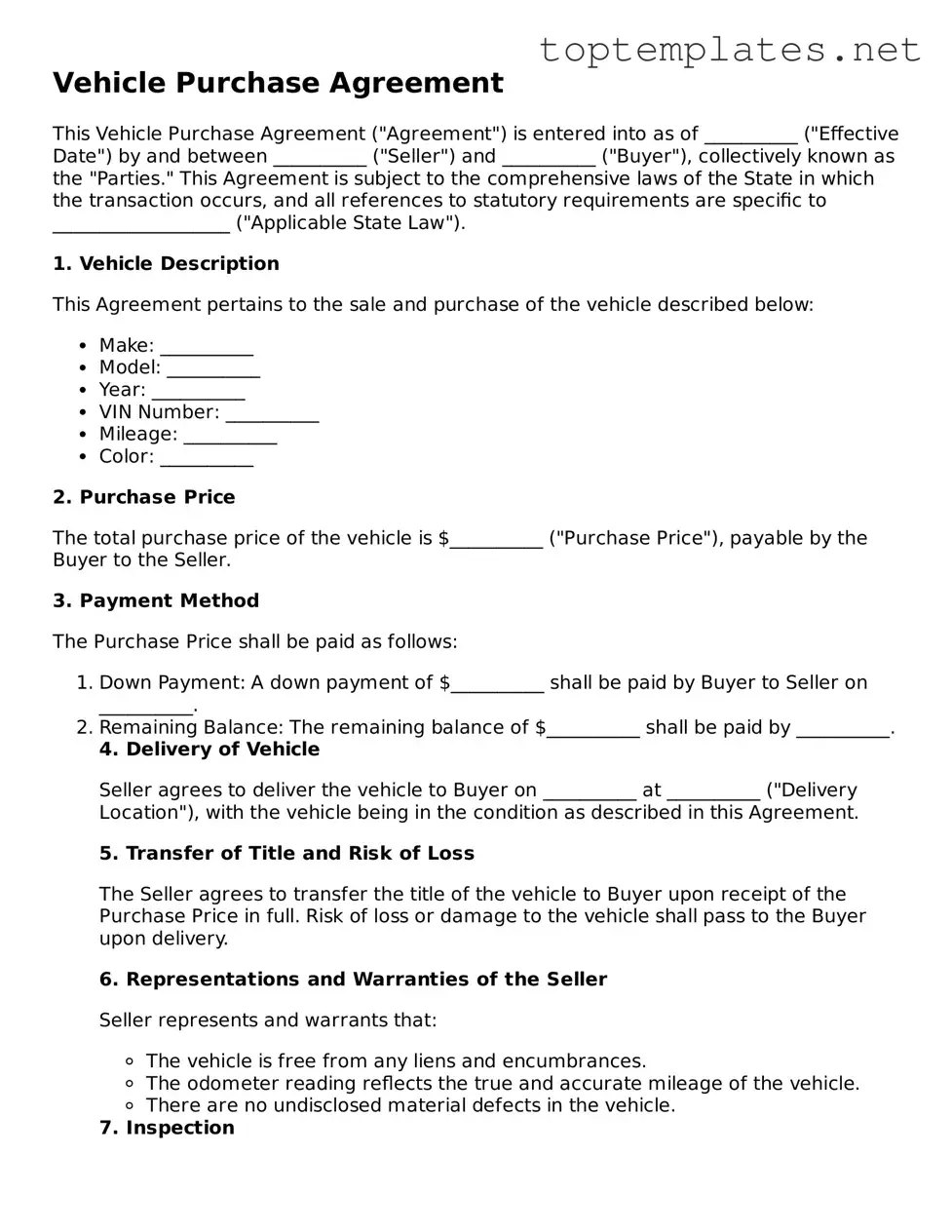What is a Vehicle Purchase Agreement?
A Vehicle Purchase Agreement is a legal contract between a buyer and a seller that outlines the terms and conditions of the sale of a vehicle. It typically includes details such as the identities of the buyer and seller, a description of the vehicle (including make, model, year, and VIN), the purchase price, payment methods, and any warranties or guarantees. This document provides legal protection for both parties and ensures that everyone is clear on the terms of the sale.
Why is it necessary to have a Vehicle Purchase Agreement?
Having a Vehicle Purchase Agreement is essential because it legally documents the sale and transfer of ownership of the vehicle. This agreement serves as a record of the transaction, helping to resolve any future disputes that may arise regarding the sale. It also ensures that the seller legally transfers the title of the vehicle to the buyer, which is critical for registering the vehicle in the buyer's name.
What should be included in a Vehicle Purchase Agreement?
A comprehensive Vehicle Purchase Agreement should include the full names and contact information of both the buyer and seller, a detailed description of the vehicle being sold (including the VIN, make, model, year, and mileage), the sale price and payment arrangement, information about any warranties or guarantees, the sale date, and signatures from both parties. It may also include terms regarding a vehicle inspection, delivery arrangements, and any agreed-upon repairs or conditions.
Is a Vehicle Purchase Agreement legally binding?
Yes, once both the buyer and seller sign the Vehicle Purchase Agreement, it becomes a legally binding contract. The terms outlined in the agreement are enforceable by law, meaning that if one party fails to meet their obligations as stated in the document, the other party has the right to seek legal remedy. This might involve suing for damages or enforcing specific performance of the agreement's terms.
Can changes be made to a Vehicle Purchase Agreement after signing?
Yes, changes can be made to a Vehicle Purchase Agreement after it has been signed, but any modifications must be agreed upon by both the buyer and the seller. The best way to make changes is to create a written amendment to the agreement, which should be signed by both parties. This amendment then becomes part of the original agreement.
Do I need a lawyer to create a Vehicle Purchase Agreement?
While you do not necessarily need a lawyer to create a Vehicle Purchase Agreement, consulting with one can ensure that the agreement is legally sound and protective of your rights. A lawyer can provide advice on the specific terms that should be included based on your circumstances, help negotiate terms, and ensure that the agreement complies with all applicable laws.
How does a Vehicle Purchase Agreement protect the buyer?
A Vehicle Purchase Agreement protects the buyer by documenting the condition of the vehicle at the time of sale, including any warranties or guarantees. It ensures that the buyer receives clear title to the vehicle, outlines the payment terms, and provides legal recourse if the seller fails to meet their obligations as specified in the agreement. Essentially, it gives the buyer proof of ownership and a clear pathway to seek remedy if the agreement's terms are not honored.
How does a Vehicle Purchase Agreement protect the seller?
For the seller, a Vehicle Purchase Agreement provides documentation that the vehicle has been legally sold and transferred to the buyer. It can specify the condition of the vehicle at the time of sale, reducing the risk of future disputes over its condition. Furthermore, by documenting the receipt of payment as agreed upon, it protects the seller from claims of non-payment. Essentially, it offers peace of mind that the sale has been completed according to the agreed-upon terms.
